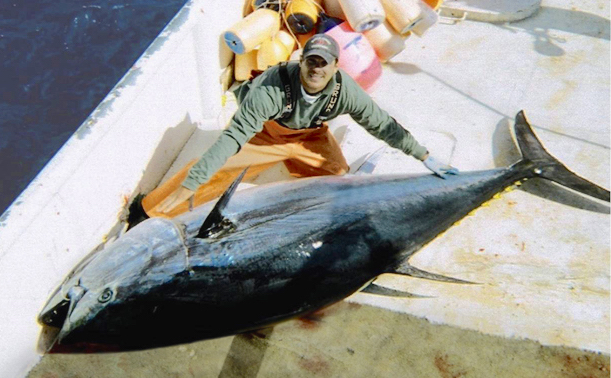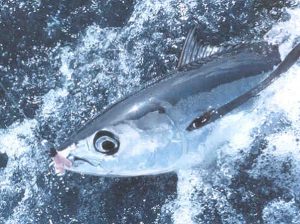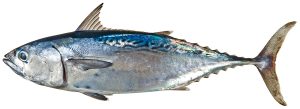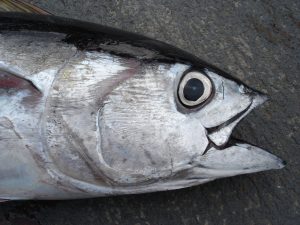Maine Seafood Guide – Tuna

Season
Status
Regulatory Authority
Harvest Method
Recreational Harvest
Health Benefits & Risks
Buying & Preparing
Brands
Certifications
Links
►Species Description
Atlantic bluefin tuna Thunnus thynnus
Bigeye tuna Thunnus obesus
Albacore tuna Thunnus alalunga
Skipjack tuna Katsuwonus pelamis
Little tunny Euthynnus alletteratus
Bonito Sarda sarda
View gallery of species.
Wild.
Tunas make long migrations across the open ocean between spawning and feeding areas. For example, a good number of bluefin tuna found in the Gulf of Maine also spend time in the Gulf of Mexico, one of their primary spawning grounds.
Bluefin tuna are surface-dwelling, cold-tolerant, high-jumping, fast-swimming, and one of the largest fishes in the Gulf of Maine, commonly reaching lengths over six feet. The other tunas are much smaller (around 25 inches).
Bonito has dark stripes on its back and a long first dorsal fin. When pursuing prey, bonito jump and skip over the water surface. Bonito occur in the western Gulf of Maine, as far north as Cape Ann and Casco Bay.
Skipjack tuna has long, dark stripes along the belly and sides. Rare in the Gulf of Maine, skipjack occasionally are encountered off Cape Cod and Georges Bank.
The little tunny is similar to skipjack with dark spots on the side and wavy markings on the back. They are less migratory and may be found closer to shore. Little tunny are rare in the Gulf of Maine, occasionally caught in Cape Cod Bay.
Albacore and bigeye tuna only occasionally enter the Gulf of Maine.
►Season
Bluefin: June-September
Bonito: July-October
Skipjack: June-October
Little tunny: July-August
►Status
Atlantic bluefin tuna in the Western Atlantic are overfished, but overfishing is not occurring (as of Dec. 2014).
Bonito status is unknown. Atlantic skipjack populations are believed to be healthy.
The stock of Atlantic bigeye tuna are not overfished, but overfishing is occuring as the stock rebuilds to target population levels.
Little tunny status is unknown.
Atlantic albacore tuna is not subject to overfishing nor is overfishing occuring, according to the latest (2013) stock assessment. The population is still rebuilding.
►Regulatory Authority
Atlantic bluefin, bigeye, skipjack, and albacore tuna are managed under the dual authority of the National Marine Fisheries Service Highly Migratory Species Division and the International Commission for the Conservation of Atlantic Tunas (ICCAT).
►Harvest Method
Harpoon, purse seine, longline. See the vessel and gear guide for more information.
►Recreational Harvest
Only from a vessel with an Atlantic HMS angling permit.
►Health Benefits & Risks
Bluefin tuna is a very good source of vitamin A, vitamin B12, and selenium. Bluefin tuna is also high in omega-3 fatty acids. Because bluefin tuna is a large, long-lived species that eats other fish, it may contain high levels of mercury.
Atlantic bigeye (“ahi”) tuna is a good source of selenium, vitamins B6 and B12, but is lower in omega-3 fatty acids than other types of tuna. Bigeye tuna can be high in mercury.
Skipjack (“light”) tuna is a good source of selenium and tends to be lower in mercury than other tunas. Skipjack tuna also tends to be slightly lower in omega-3 fatty acids than other types of tuna.
Albacore tuna is a very good source of vitamin B12, selenium, and omega-3 fatty acids. Canned albacore (“white”) tuna has more mercury than skipjack (“light” tuna).
![]() There is a consumption advisory for tuna; Maine Center for Disease Control and Prevention advises that pregnant and nursing women, women who may get pregnant and children under eight years old eat no more than one can of “white” tuna or two cans of “light” tuna per week.
There is a consumption advisory for tuna; Maine Center for Disease Control and Prevention advises that pregnant and nursing women, women who may get pregnant and children under eight years old eat no more than one can of “white” tuna or two cans of “light” tuna per week.
►Buying & Preparing
Tuna is not always labeled by species. Ask the fishmonger if the kind of tuna is known, as well as where it came from.
Tuna flesh ranges from very light pink (nearly white) to deep reddish brown, depending on the species. Avoid those with strong discoloration, or which have a dull, brownish cast or brown spots. The flesh should be firm and smell fresh, not “fishy.”
►Companies, Brands, and Labels
None
►Certifications & Verifications
None
►Links
 |
 |
 |
